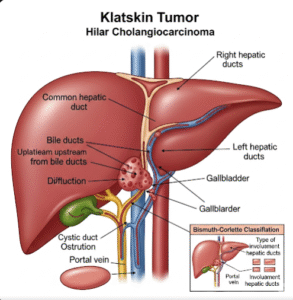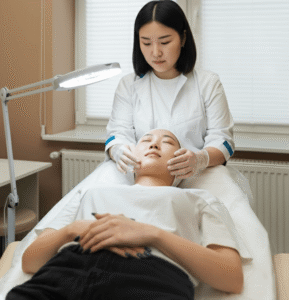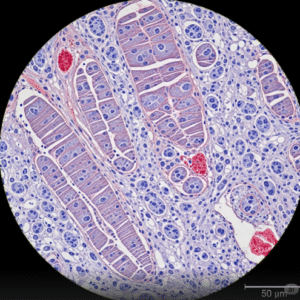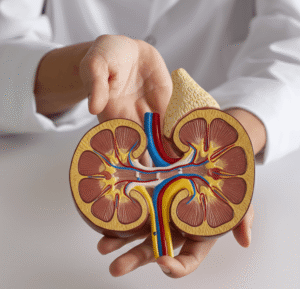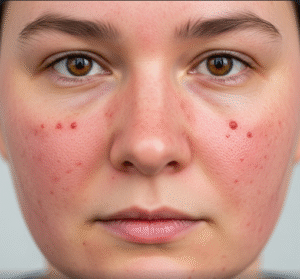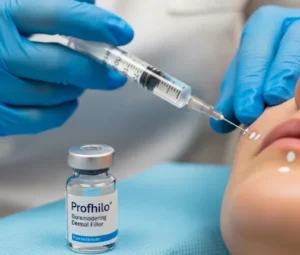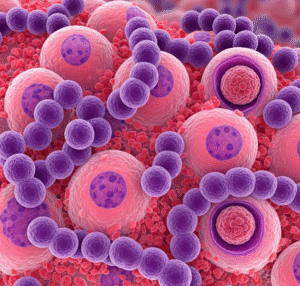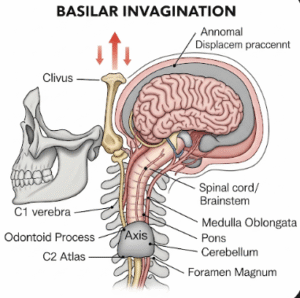➤ Overview
Terry’s Nails is a nail condition characterized by white or pale discoloration of the nail beds with a narrow band of pink or red at the tip. It is often a sign of systemic illness rather than a primary nail problem. The condition is named after Dr. Richard Terry, who first described it in association with liver disease.
In South Korea, Terry’s Nails are often observed during routine check-ups, dermatology consultations, or internal medicine evaluations, helping clinicians identify potential underlying conditions early. Recognition of this nail change can prompt timely investigation of liver, kidney, or cardiac disorders.
➤ Key Facts
→ Terry’s Nails typically appear as white or pale nails with a 1–3 mm pink distal band.
→ The condition may affect one or more nails, often fingernails first.
→ It is more common in older adults but can occur at any age depending on underlying illness.
→ Associated with systemic diseases such as liver cirrhosis, congestive heart failure, diabetes, or kidney disease.
→ In Korea, dermatologists and internists use nail examination as part of a holistic health assessment.
→ Terry’s Nails are painless and usually asymptomatic, noticed visually rather than causing discomfort.
→ Early identification can lead to diagnosis and management of serious underlying health conditions.
➤ What is Terry’s Nails?
Terry’s Nails are a physical sign indicating changes in the vascular bed and nail matrix, leading to:
→ White or opaque nail beds – The majority of the nail appears pale.
→ Pink or red distal band – Narrow band near the tip, usually 1–3 mm.
→ Smooth nail surface – Nails remain smooth without pitting or ridges.
→ Symmetrical appearance – Typically affects all fingernails, but can be asymmetrical.
→ Gradual development – Nail changes may appear over weeks or months.
In South Korea, physicians assess Terry’s Nails alongside patient history, systemic symptoms, and lab investigations to determine underlying causes.
➤ What Symptoms are Related to Terry’s Nails?
While Terry’s Nails themselves are asymptomatic, they are often associated with symptoms of underlying systemic conditions:
→ Fatigue and weakness → Common in liver or kidney disease.
→ Jaundice → Yellowing of skin or eyes, often in liver dysfunction.
→ Edema → Swelling in legs or hands from heart or kidney disease.
→ Shortness of breath → Seen in congestive heart failure.
→ Abdominal discomfort or swelling → Indicative of liver cirrhosis or ascites.
→ Weight changes → Unintentional weight loss or gain depending on systemic illness.
→ Itching or skin changes → May accompany liver disorders.
→ General malaise or lethargy → Often present in chronic systemic disease.
➤ What Causes / Possible Causes?
Terry’s Nails are associated with multiple systemic conditions affecting vascular supply or nail bed appearance:
→ Liver disease – Cirrhosis, hepatitis, or chronic liver failure.
→ Congestive heart failure – Reduced circulation affecting nail bed color.
→ Diabetes mellitus – Microvascular changes leading to pale nails.
→ Chronic kidney disease – Uremia and systemic metabolic effects.
→ Aging – Nail changes can appear naturally with age, though less pronounced.
→ Hyperthyroidism or hypothyroidism – Rarely, thyroid dysfunction may alter nail appearance.
→ Malnutrition – Deficiencies in protein, vitamins, or minerals.
→ Other systemic illnesses – Cancer, chronic infections, or endocrine disorders.
In Korea, doctors often use blood tests, liver function tests, kidney function tests, and cardiovascular assessment to identify the underlying condition.
➤ When Should I See My Doctor?
Medical consultation is advised if Terry’s Nails appear suddenly, progressively, or alongside other systemic symptoms:
→ Nail color changes appear in multiple fingers simultaneously.
→ Associated jaundice, fatigue, edema, or shortness of breath.
→ Presence of unexplained weight loss or chronic malaise.
→ History of chronic disease where nail changes may indicate worsening condition.
→ Family members or caregivers notice progressive nail whitening or distal band changes.
→ Any concern about systemic health that could be related to nail appearance.
Early evaluation in Korea ensures prompt diagnosis and management of potentially serious underlying health issues.
➤ Care and Treatment
Terry’s Nails themselves do not require treatment, but management focuses on addressing the underlying cause:
→ Liver disease management – Medications, lifestyle changes, or monitoring for cirrhosis.
→ Heart failure management – Diuretics, ACE inhibitors, beta-blockers, and dietary modifications.
→ Diabetes management – Blood sugar control, diet, and regular monitoring.
→ Kidney disease management – Dialysis, medications, and nutritional guidance.
→ Nutritional support – Correcting deficiencies of protein, vitamins, or minerals.
→ Regular monitoring – Observation of nail changes to assess progression or improvement.
→ Patient education – Awareness that nail appearance can reflect systemic health.
→ Lifestyle modifications – Healthy diet, exercise, and avoiding hepatotoxic or nephrotoxic substances.
➤ Treatment Options in Korea
South Korea provides comprehensive care for patients with Terry’s Nails and underlying conditions:
Diagnosis in Korea
→ Clinical examination – Visual inspection of nails and systemic evaluation.
→ Laboratory tests – Liver function tests, kidney function panels, glucose, and thyroid levels.
→ Imaging studies – Ultrasound, CT scan, or echocardiography for internal organ assessment.
→ Specialist consultation – Hepatology, nephrology, cardiology, or endocrinology as needed.
Medical Treatments in Korea
→ Pharmacological therapy – Medications targeting liver disease, heart failure, diabetes, or kidney disease.
→ Lifestyle and diet counseling – Nutritional guidance to support systemic health.
→ Monitoring and follow-up – Regular assessment of lab values, nail appearance, and overall health.
Advanced Therapies in Korea
→ Liver transplantation – For advanced cirrhosis or liver failure.
→ Dialysis or renal replacement therapy – For chronic kidney disease patients.
→ Cardiac interventions – Pacemaker, valve repair, or advanced heart failure management.
→ Integrated care programs – Combining specialists, nutritionists, and lifestyle coaches for holistic management.
Rehabilitation & Support in Korea
→ Education on recognizing nail changes as indicators of systemic health.
→ Support for chronic disease management, monitoring, and lifestyle adaptation.
→ Collaboration among dermatologists, internists, and specialized clinics for comprehensive care.




